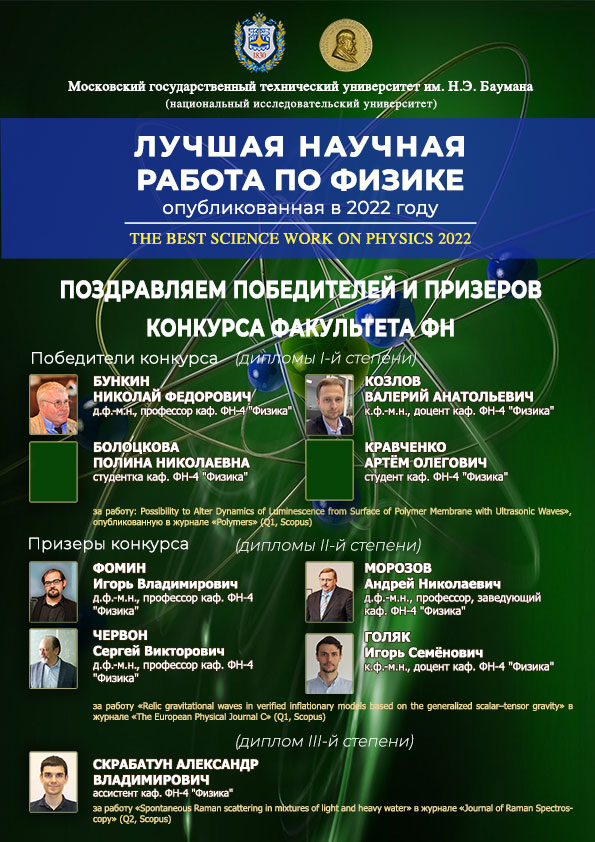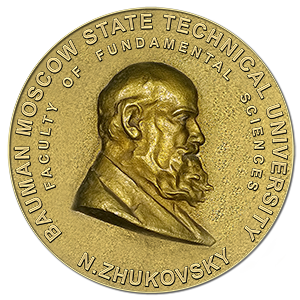
In order to encourage research in mathematics and physics, the Bauman Moscow State Technical University held competitions for the best scientific papers in mathematics and physics among those published in 2022.
After much deliberation, the top rankings in the physics paper competition were awarded to the following employees of the FN-4 department:
1st place
Bunkin Nikolay Fedorovich, D. Sc. (Phys. Math.), Professor
Kozlov Valeriy Anatolyevich, Cand. Sc. (Phys. Math.), Associate Professor
Bolotskova Polina Nikolaevna, student
Kravchenko Artem Olegovich, student
for the paper "Possibility to Alter Dynamics of Luminescence from Surface of Polymer Membrane with Ultrasonic Waves", published in Polymers (Q1, Scopus).
The paper investigates the temporal dynamics of luminescence emitted by Nafion polymer membrane surfaces in natural water (with the deuterium content of 157 ppm) and deuterium-depleted water (with the deuterium content of 3 ppm). The authors show that, as Nafion expands in natural water, its polymer fibers unwind towards the bulk of the fluid, while in deuterium-depleted water this effect is not observed. The experiments established as a fact that the centers (donors) of luminescence are sulfonic groups located on unwound polymer fibers; assuming that the luminescence acceptors (modified sulfonic groups) are also located on these fibers, we put forward a hypothesis that it may be possible to control the resonant donor-acceptor energy transfer. The investigation shows that the distance between donors and acceptors may be varied via emitting ultrasonic waves towards each other along the polymer membrane. Being absorbed by the layer containing unwound fibers, these waves transmit their momentum to the particles of the fluid; that is, two acoustic streams are generated, directed towards each other. By measuring the velocity of these flows it is possible to estimate the bulk-to-shear viscosity ratio in the layer containing unwound fibers. This way, by applying ultrasound to a polymer membrane that expands in ordinary water, it should be possible to control the luminescence intensity dynamics, and therefore to control the expansion of the polymer membrane, which should improve the efficiency of using Nafion in fuel cells or for dehydration or humidification of gases.
2nd place
Fomin Igor Vladimirovich, D. Sc. (Phys. Math.), Professor
Chervon Sergey Viktorovich, D. Sc. (Phys. Math.), Professor
Morozov Andrey Nikolaevich, D. Sc. (Phys. Math.), Head of the Department, Professor
Golyak Ilya Semenovich, Junior Research Fellow at the Scientific Research Department of the Scientific Educational Complex of Fundamental Sciences
for the paper "Relic gravitational waves in verified inflationary models based on the generalized scalar-tensor gravity" in The European Physical Journal C (Q1, Scopus).
This paper considers cosmological inflationary models based on the generalized scalar-tensor theory of gravity with a quadratic relation between the Hubble parameter and non-minimal coupling functions. The authors studied how physically motivated scalar field potentials relate to known types of generalized scalar-tensor gravity models. The approach proposed opens up new opportunities for developing novel phenomenologically correct cosmological theories and differs significantly from the procedure for reconstructing the scalar potential of the field from the cosmological perturbation parameters within the general relativity framework. The spectrum of relic gravitational waves arising in the models considered is analyzed. The frequency range of the maximum energy density is determined. In principle, low-frequency relic gravitational waves predicted by the cosmological models proposed may be recorded in planned ground-based and space experiments, which should make it possible to impose experimental restrictions on the parameters of the cosmological models under investigation.
3rd place
Skrabatun Alexandr Vladimirovich, Assistant Lecturer
for the paper "Spontaneous Raman scattering in mixtures of light and heavy water" in the Journal of Raman Spectroscopy (Q2, Scopus).
The paper presents the results of a rather sophisticated experiment in registering the fine structure of the combination spectra as scattered by heavy water of various isotopic composition in a wide spectral range. It should be noted that in the range investigated (10 – 4000 cm-1) the following modes are expected to manifest: 1) cluster (translational and librational) molecular modes (corresponding to the dynamics of water clusters), 2) fundamental modes (corresponding to intramolecular H2O vibrations), as well as 3) soft modes (arising from overtone transitions during Fermi resonance in HDO), which, on the one hand, complicates spectrum characterization, but on the other hand, aids in obtaining particularly valuable information about the processes taking place in the water. The authors employed group-theoretical and dynamic analysis to identify all types of SRS-active water vibrations, which is undoubtedly a considerable achievement. Using deuterated water in various concentrations made it possible to determine the type of spectrum as a function of the isotopic composition of the heavy hydrogen sample. The results obtained are important for solving fundamental and applied problems, such as investigating soft modes and cluster structure of water, or optical monitoring of the isotopic composition of heavy water.
The Rector's Office of the Bauman Moscow State Technical University will award diplomas to the winners and top ranked participants at its next session.
Congratulations to the winners!


